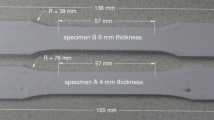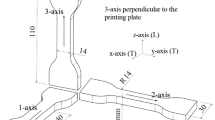Abstract
In this study, the fatigue life of notched polylactic acid (PLA) samples fabricated through the fused deposition modeling (FDM) technique was studied experimentally and numerically. The volumetric method based on the theory of critical distance was employed for fatigue life predictions. The effects of influential process parameters including raster orientation and FDM-induced defects such as voids or gaps inside the parts were examined on the fatigue strength reduction factors and fatigue lives. Circular and elliptical-shaped notch geometries were considered with various dimensions. Fatigue tests were conducted on notched and un-notched samples at the load ratio of 0.1. Predicted results were compared with experimental fatigue test data. Results revealed that the raster orientation parameter had a substantial impact on fatigue strength reduction factors and fatigue lives. The stress concentrations induced by the FDM process on the surfaces and inside the parts for the samples with 90° raster angles acted similar to the sharp notches, resulting in no substantial difference in fatigue life of notched and un-notched 3D-printed samples. In contrast, un-notched 3D-printed specimens with 0° raster orientations possessed higher fatigue lives as compared to the notched samples. While the volumetric approach efficiently predicted the fatigue lives of the samples with 90° raster orientations, it moderately underpredicted the fatigue lives of the samples with 0° raster angles.










Similar content being viewed by others
Data availability
The data presented in this study are available on request from the corresponding author.
Abbreviations
- \({\sigma }_{f}^{\mathrm{^{\prime}}}\) :
-
Fatigue strength coefficient
- \({\varepsilon }_{f}^{\mathrm{^{\prime}}}\) :
-
Fatigue ductility coefficient
- \(B\) :
-
Fatigue strength exponent
- \(c\) :
-
Fatigue ductility exponent
- \({N}_{f}\) :
-
Fatigue life cycles
- \(E\) :
-
Elastic modulus
- \({\sigma }_{max}\) :
-
Maximum stress
- \({\sigma }_{y}\) :
-
Yield strength
- \(\alpha\) :
-
Peterson’s constant
- \(\beta\) :
-
Neuber’s constant
- \(\rho\) :
-
Notch tip radius
- \(q\) :
-
Notch sensitivity
- \(a and b\) :
-
Large and small ellipse diameters
- \({X}_{eff}\) :
-
Effective distance
- \(\chi\) :
-
Stress gradient
- R :
-
Stress ratio
- \({\sigma }_{a}\) :
-
Stress amplitude
- \({\varepsilon }_{a}\) :
-
Strain amplitude
- \({K}_{f}\) :
-
Fatigue notch factor
- \({K}_{t}\) :
-
Elastic stress concentration factor
- AM :
-
Additive manufacturing
- FDM :
-
Fused deposition modeling
- PLA :
-
Polylactic acid
- UTS:
-
Ultimate tensile strength
- TCD:
-
Theory of critical distance
References
Low ZX et al (2017) Perspective on 3D printing of separation membranes and comparison to related unconventional fabrication techniques. J Membr Sci 523:596–613. https://doi.org/10.1016/j.memsci.2016.10.006
Larraza I et al (2021) Cellulose and graphene based polyurethane nanocomposites for FDM 3D printing: filament properties and printability. Polymers 13(839). https://doi.org/10.3390/polym13050839
Dizon JRC et al (2018) Mechanical characterization of 3D-printed polymers. Additive Manufacturing 20:44–67. https://doi.org/10.1016/j.addma.2017.12.002
Zhao L et al (2021) Development model and experimental characterization of residual stress of 3D printing PLA parts with porous structure. Appl Phys A 127(98). https://doi.org/10.1007/s00339-020-04238-2
Hernandez-Contreras A et al (2020) Extended CT void analysis in FDM additive manufacturing components. Materials 13(3831). https://doi.org/10.3390/ma13173831
Wang J et al (2016) A novel approach to improve mechanical properties of parts fabricated by fused deposition modeling. Mater Des 105:152–159. https://doi.org/10.1016/j.matdes.2016.05.078
Tronvoll SA, Welo T, Elverum C (2018) The effects of voids on structural properties of fused deposition modelled parts: a probabilistic approach. Int J Adv Manuf Technol 97:3607–3618. https://doi.org/10.1007/s00170-018-2148-x
Fayazbakhsh K, Movahedi M, Kalman J (2019) The impact of defects on tensile properties of 3D printed parts manufactured by fused filament fabrication. Mater Today Commun 18:140–148. https://doi.org/10.1016/j.mtcomm.2018.12.003
Kerekes TW et al (2019) Characterization of process–deformation/damage property relationship of fused deposition modeling (FDM) 3D-printed specimens. Addit Manuf 25:532–544. https://doi.org/10.1016/j.addma.2018.11.008
Fischer M, Schoppner V (2017) Fatigue behavior of FDM parts manufactured with Ultem 9085. J Miner Metals Mater Soc 69(3):563–568. https://doi.org/10.1007/s11837-016-2197-2
Ezeh OH, Susmel L (2019) Fatigue strength of additively manufactured polylactide (PLA): effect of raster angle and non-zero mean stresses. Int J Fatigue 126:319–326. https://doi.org/10.1016/j.ijfatigue.2019.05.014
Ziemian S, Okwara M, Ziemian C (2015) Tensile and fatigue behavior of layered acrylonitrile butadiene styrene. Rapid Prototyp J 21(3):270–278. https://doi.org/10.1108/RPJ-09-2013-0086
Afrose MF et al (2016) Effects of part build orientations on fatigue behaviour of FDM-processed PLA material. Prog Addit Manuf 1:21–28. https://doi.org/10.1007/s40964-015-0002-3
Brenne F, Niendorf T (2019) Effect of notches on the deformation behavior and damage evolution of additively manufactured 316L specimens under uniaxial quasi-static and cyclic loading. Int J Fatigue 127:175–189. https://doi.org/10.1016/j.ijfatigue.2019.05.018
Nicoletto G et al (2020) Influence of layer-wise fabrication and surface orientation on the notch fatigue behavior of as-built additively manufactured Ti6Al4V. Int J Fatigue 134:1–10. https://doi.org/10.1016/j.ijfatigue.2020.105483
Chan KS, Peralta-Duran A (2019) A methodology for predicting surface crack nucleation in additively manufactured metallic components. Metall Mater Trans A 50A:4378–4387. https://doi.org/10.1007/s11661-019-05309-7
Kahlin M, Ansell H, Moverare JJ (2017) Fatigue behaviour of notched additive manufactured Ti6Al4V with as-built surfaces. Int J Fatigue 101:51–60. https://doi.org/10.1016/j.ijfatigue.2017.04.009
Nicoletto G (2018) Directional and notch effects on the fatigue behavior of as-built DMLS Ti6Al4V. Int J Fatigue 106:124–131. https://doi.org/10.1016/j.ijfatigue.2017.10.004
Ahmed AA, Susmel L (2018) A material length scale–based methodology to assess static strength of notched additively manufactured polylactide (PLA). Fatigue Fract Eng Mater Struct 41:2071–2098. https://doi.org/10.1111/ffe.12746
Ahmed AA, Susmel L (2019) Static assessment of plain/notched polylactide (PLA) 3D-printed with different infill levels: equivalent homogenised material concept and Theory of Critical Distances. Fatigue Fract Eng Mater Struct 42:883–904. https://doi.org/10.1111/ffe.12958
Ng CT, Susmel L (2020) Notch static strength of additively manufactured acrylonitrile butadiene styrene (ABS). Addit Manuf 34:1–15. https://doi.org/10.1016/j.addma.2020.101212
Ezeh OH, Susmel L (2020) On the notch fatigue strength of additively manufactured polylactide (PLA). Int J Fatigue 136:1–12. https://doi.org/10.1016/j.ijfatigue.2020.105583
Solberg K, Wan D, Berto F (2020) Fatigue assessment of as-built and heat-treated Inconel 718 specimens produced by additive manufacturing including notch effects. Fatigue Fract Eng Mater Struct 43:2326–2336. https://doi.org/10.1111/ffe.13300
Solberg K, Berto F (2020) A diagram for capturing and predicting failure locations in notch geometries produced by additive manufacturing. Int J Fatigue 134:1–6. https://doi.org/10.1016/j.ijfatigue.2019.105428
Molaei R, Fatemi A (2021) Fatigue performance of additive manufactured metals under variable amplitude service loading conditions including multiaxial stresses and notch effects: experiments and modelling. Int J Fatigue 145:1–15. https://doi.org/10.1016/j.ijfatigue.2020.106002
Papon EA, Haque A (2018) Tensile properties, void contents, dispersion and fracture behaviour of 3D printed carbon nanofiber reinforced composites. J Reinf Plast Compos 37(6):381–395. https://doi.org/10.1177/0731684417750477
Francis V, Jain P (2016) Experimental investigations on fused deposition modelling of polymer-layered silicate nanocomposite. Virtual and Phys Prototyp 11(2):109–121. https://doi.org/10.1080/17452759.2016.1172431
Dowling NE (2003) Mechanical behavior of materials, engineering methods for deformation, fracture, and fatigue, 4th edn. Angshuman Chakraborty
Smith KN, Watson P, Topper T (1970) A stress strain function for the fatigue of metals. J Eng Mater Technol 5(4):767–778
Hassanifard S, Hashemi SM (2020) On the strain-life fatigue parameters of additive manufactured plastic materials through fused filament fabrication process. Addit Manuf 32:100973. https://doi.org/10.1016/j.addma.2019.100973
Neuber H (1961) Translation theory of notch stresses, principles for exact stress calculations. 1958, US Office of Technical Services, Springer, Washington, DC
Peterson RE (1959) Notch sensitivity. In: Sines G, Waisman JL (eds) Metal Fatigue, pp 293–306
Tanaka K (1983) Engineering formulae for fatigue strength reduction due to crack-like notches. Int J Fract 22:R39–R45. https://doi.org/10.1007/BF00942722
Taylor D (1999) Geometrical effects in fatigue: a unifying theoretical model. Int J Fatigue 21:413–420. https://doi.org/10.1016/S0142-1123(99)00007-9
Pluvinage G (2004) Fracture and fatigue emanating from stress concentrators. Kluwer Academic Publishers
Averett RD et al (2011) The mechanical behavior of poly(lacticacid) unreinforced and nanocomposite films subjected to monotonic and fatigue loading conditions. J Compos Mater 45(26):2717–2726. https://doi.org/10.1177/0021998311410464
Funding
This research was supported by the Natural Sciences and Engineering Research Council of Canada (NSERC under grant RGPIN-217525). The authors are grateful for their support.
Author information
Authors and Affiliations
Corresponding author
Ethics declarations
Ethics approval
All professional ethics have been followed.
Consent to participate
Not applicable.
Consent for publication
Not applicable.
Conflict of interest
The authors declare no competing interests.
Additional information
Publisher's note
Springer Nature remains neutral with regard to jurisdictional claims in published maps and institutional affiliations.
Rights and permissions
About this article
Cite this article
Hassanifard, S., Behdinan, K. Effects of voids and raster orientations on fatigue life of notched additively manufactured PLA components. Int J Adv Manuf Technol 120, 6241–6250 (2022). https://doi.org/10.1007/s00170-022-09169-1
Received:
Accepted:
Published:
Issue Date:
DOI: https://doi.org/10.1007/s00170-022-09169-1




